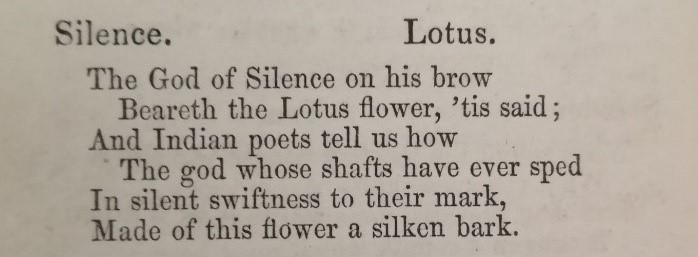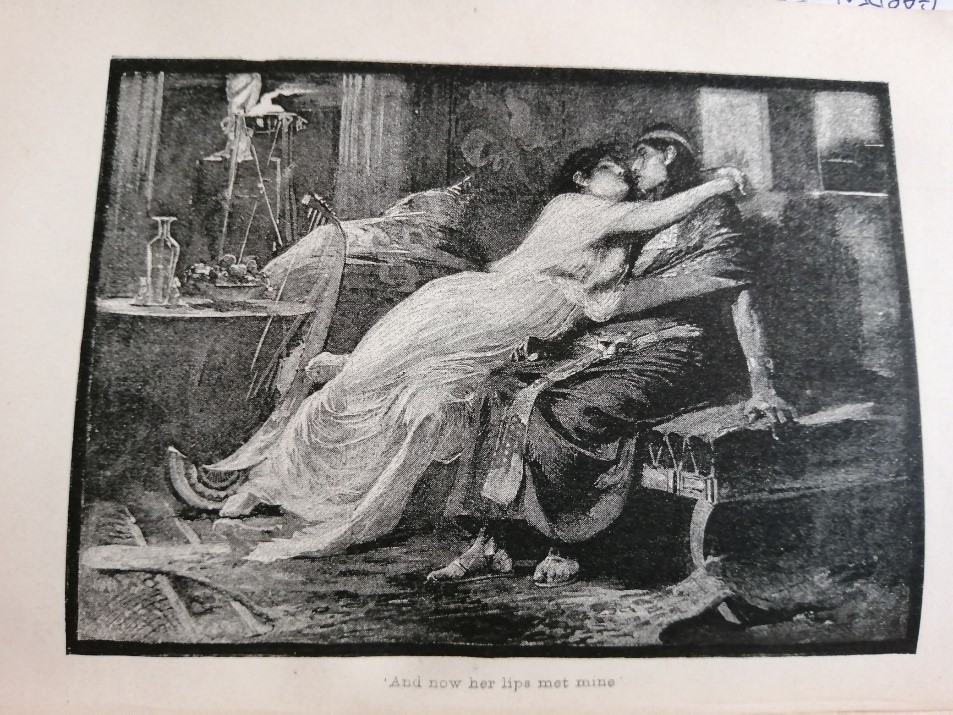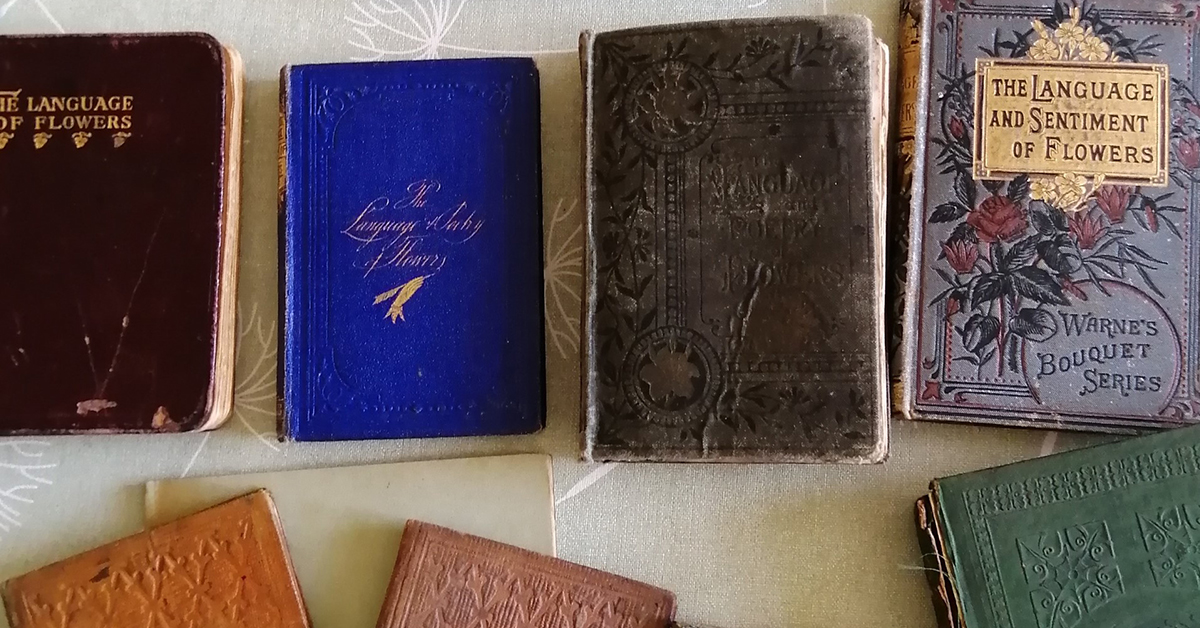
By Jemma Stewart
Read Part 1 of this blog series.
Lotus
And as the voice spoke, a cold hand touched my hand … As the light came back, I gazed upon that which had been left within my hand. It was a bud of the holy lotus new breaking into bloom, and from it came a most sweet scent. And while I gazed behold! the lotus passed from my grasp and was gone, leaving me astonished. (37)
The lotus flower proliferated Ancient Egyptian culture. In The Culture of Flowers, Jack Goody asserts that the lotus flower was ‘central to mythology’ and ‘…the Egyptian lotus or waterlily (Nymphaea) had strong religious connotations and the white and blue varieties were constantly used in offerings to the gods as well as to adorn humans’ (p. 39, p. 37). The god Nefertum was the ‘God of the primeval lotus-blossom’, and very recently in 2020 a statue of the god has been uncovered along with 59 coffins and mummified remains in Saqqara. We might also look at items in the British Museum or the Victoria and Albert museum to confirm the Ancient Egyptian reverence for the lotus: see perhaps this ‘green glazed composition amulet in the form of an opening lotus bud’; this painted cartonnage mummy-case ‘adorned with lappet-bands and lotus flowers and rosettes’; this glazed composition dish potentially used in ritual rather than domestic routine, of the blue lotus ‘associated with the daily rebirth of the sun god’; this green glazed ring ‘with moulded lotus-form decoration at either end of the bezels’; and perhaps this blue glazed composition chalice in the form of the lotus, the ‘ubiquitous symbol of new life’.
The lotus flower heralds failure and doom for Harmachis, the priest of Isis hoping to overthrow Cleopatra and become Pharaoh, supplanting one of its traditional meanings of rebirth or regeneration. In Flower Favourites, Lizzie Deas notes that lotus was dedicated to ‘the moon-goddess, Isis’ and that,
As emblematic of mystery and of sanctity, the Lotus enters largely into the symbol of worship of the East, and from earliest time has been an object, not only of reverence, but of actual adoration. The Egyptians cultivated three species of water lily: the nelumbium speciosum, whose flowers are of a lovely roseate colour; the nymphoea coerulea, a blue lotus; and the nymphaea, a white lotus, which last still grows in great profusion in Lower Egypt.[i]
In the Victorian language of flowers meanings of the lotus can be diverse but include (depending on the part of the plant you are focussing on), ‘eloquence’, ‘recantation’ or ‘estranged love’. The flower can also represent ‘silence’, perhaps in a nice echo of Alfred Lord Tennyson’s ‘The Lotos-Eaters’ (1832). The multifarious potential of the lotus in the language of flowers signifies its gothic capabilities.

‘Death drew near to me and his shape was Silence’ (Harmachis in Cleopatra, 63).
The sudden vanishing of the lotus in Harmachis’s visionary experience is portentous – his plans on behalf of ‘holy Isis’ are thwarted by Cleopatra, and she is able to vanquish her rival for the rule of Egypt – enslaving him to her through feminine charms. It is fitting that she cuts through the lotus flowers that are pushed under the ‘pink flaxen bandages’ of the mummified Pharaoh ‘Menkau-ra’ (183). This act betokens her lack of respect for the deceased and the treasures that she steals to shore up her reign. As such, she invokes the curse of Menkau-ra – symbolised in the ‘grey and mighty bat’, ‘the grey Horror’ (323) – that haunts her until the moment of her own demise (177-78; 190-91; 323).
Now Cleopatra took my dagger, and with it cut loose the bandages which held the wrappings in their place, and the lotus flowers that had been set in them by loving hands, three thousand years before, fell down upon the pavement. (186)
Poppy
For, since to all the Brood of Earth Death hands his poppy-flowers, he is indeed happy to whom there is occasion given to weave them into a crown of glory. (75)
The poppy has been, according to Debra N. Mancoff, ‘long a symbol of sleep and oblivion’[ii] and for Marina Heilmeyer the ‘poppy unites heaven and hell, abundance and dearth, life and death’.[iii] Poppies are used by wily Cleopatra to foil her attempted murder by Harmachis and to ensnare him, rather than as an anodyne, consolation or comfort through sleep as the Victorian language of flowers reiterates time and again. This is the moment that Cleopatra uses a ‘poppied draught’ (314) to turn the tide of events in her favour:
‘Now pledge me,’ she sighed; ‘pledge me one cup of wine in token of thy love.’
I took the draught, and I drank deep; then too late I knew that it was drugged […]
Then sight left me; and in my ears I only heard the song of the nightingale, the murmur of the sea, and the music of Cleopatra’s laugh of victory. And as I sank away, the sound of that low laugh still followed me into the land of sleep, and still follows me through life to death. (152)
‘Oh, never can I forget the look in the eyes of that fallen prince, that foresworn priest, that discrowned Pharaoh, when, lost in the poppied draught, I saw him sink into a shameful sleep when he might no more wake with honour.’ (314)

Read the final post in this blog series.
[i] Lizzie Deas, ‘The White Water Lily’ in Flower Favourites: Their Legends, Symbolism and Significance (London: George Allen, 1898), pp. 221-24 (p. 221).
[ii] Debra N. Mancoff, ‘Beata Beatrix (1864-70): Dante Gabriel Rosetti) in Flora Symbolica: Flowers in Pre-Raphaelite Art (London, Prestel, 2003), p. 60.
[iii] Marina Heilmeyer, ‘Poppy’ in The Language of Flowers: Symbols and Myths (London: Prestel, 2001), p. 58.

Gothic Studies is the journal of the International Gothic Association, and covers the field of Gothic studies from the eighteenth century to the present day, providing an international platform for dialogue and cultural criticism in the sphere of Gothic from within every period and media form. Find out how to subscribe, or recommend to your library.





